HRM Long-term Value Creation for Stakeholders Case Study
VerifiedAdded on 2023/01/20
|7
|1818
|24
Case Study
AI Summary
This case study delves into the critical role of Human Resource Management (HRM) in fostering long-term value creation for stakeholders. It highlights how HRM transcends mere administrative functions, encompassing strategic, transactional, and advisory roles essential for organizational success. The study emphasizes the importance of understanding the external economic environment and stakeholder expectations to define effective HR practices. It explores how strategic HRM aligns with business objectives, identifying deliverables and utilizing workforce data to address staffing issues. The case study also examines the significance of transactional roles in maintaining core HR functions and the advisory role in facilitating employee relations. Furthermore, it underscores the challenges HRM faces in ensuring sustainability, adapting to global markets, and fostering a competitive advantage through talent management. The research, supported by academic sources, concludes that HRM, through its practices, is central to achieving organizational goals and generating sustained value for all stakeholders.
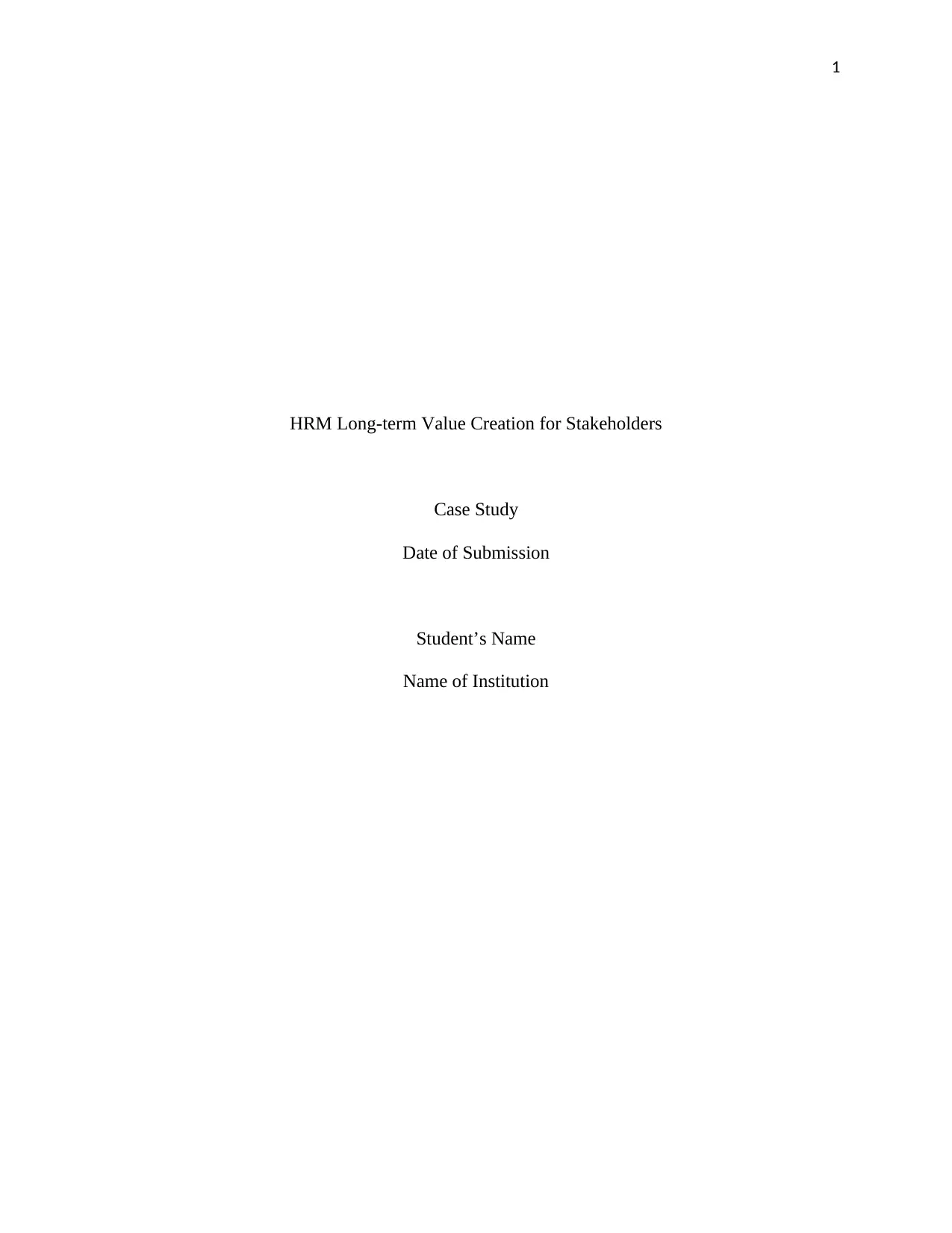
1
HRM Long-term Value Creation for Stakeholders
Case Study
Date of Submission
Student’s Name
Name of Institution
HRM Long-term Value Creation for Stakeholders
Case Study
Date of Submission
Student’s Name
Name of Institution
Secure Best Marks with AI Grader
Need help grading? Try our AI Grader for instant feedback on your assignments.
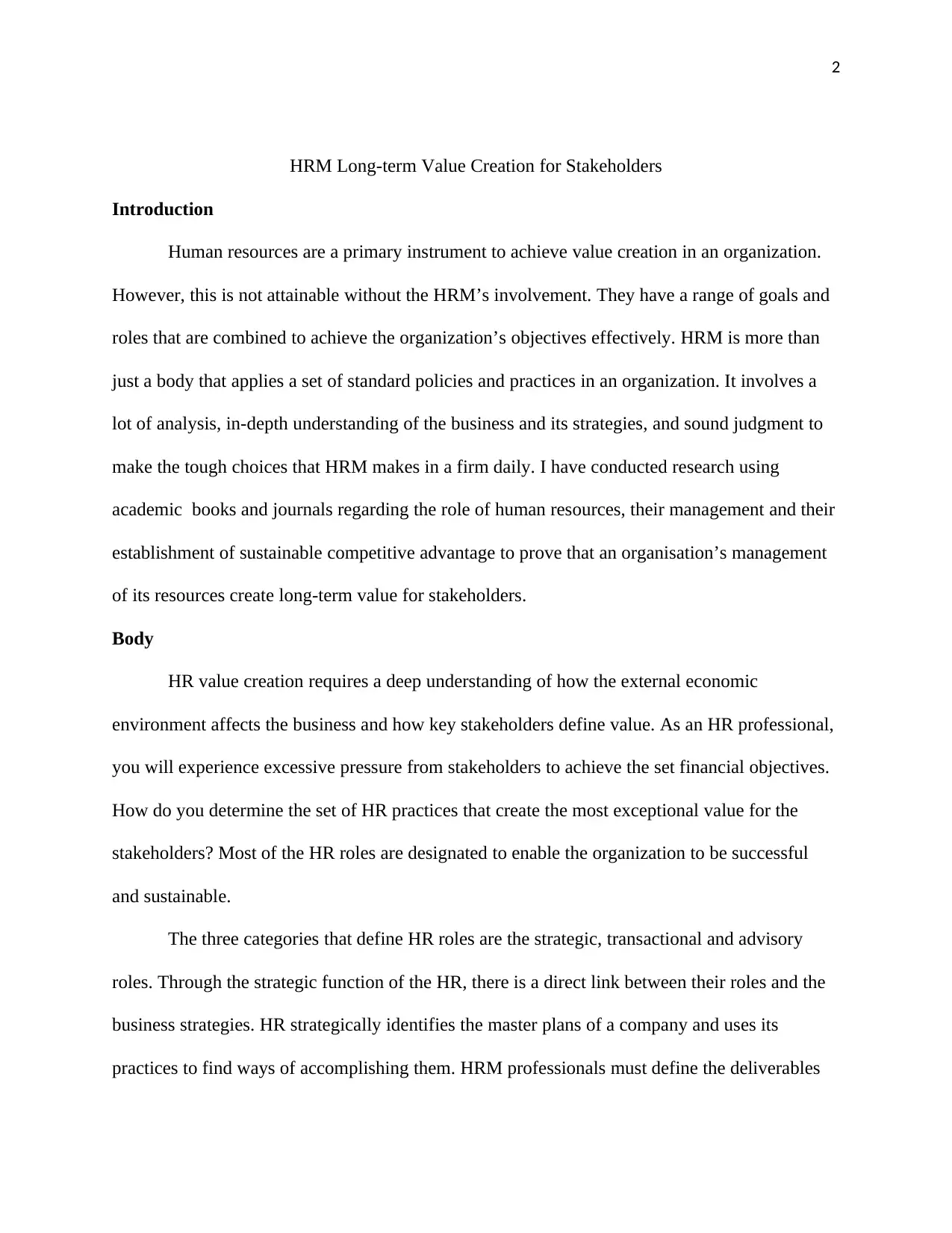
2
HRM Long-term Value Creation for Stakeholders
Introduction
Human resources are a primary instrument to achieve value creation in an organization.
However, this is not attainable without the HRM’s involvement. They have a range of goals and
roles that are combined to achieve the organization’s objectives effectively. HRM is more than
just a body that applies a set of standard policies and practices in an organization. It involves a
lot of analysis, in-depth understanding of the business and its strategies, and sound judgment to
make the tough choices that HRM makes in a firm daily. I have conducted research using
academic books and journals regarding the role of human resources, their management and their
establishment of sustainable competitive advantage to prove that an organisation’s management
of its resources create long-term value for stakeholders.
Body
HR value creation requires a deep understanding of how the external economic
environment affects the business and how key stakeholders define value. As an HR professional,
you will experience excessive pressure from stakeholders to achieve the set financial objectives.
How do you determine the set of HR practices that create the most exceptional value for the
stakeholders? Most of the HR roles are designated to enable the organization to be successful
and sustainable.
The three categories that define HR roles are the strategic, transactional and advisory
roles. Through the strategic function of the HR, there is a direct link between their roles and the
business strategies. HR strategically identifies the master plans of a company and uses its
practices to find ways of accomplishing them. HRM professionals must define the deliverables
HRM Long-term Value Creation for Stakeholders
Introduction
Human resources are a primary instrument to achieve value creation in an organization.
However, this is not attainable without the HRM’s involvement. They have a range of goals and
roles that are combined to achieve the organization’s objectives effectively. HRM is more than
just a body that applies a set of standard policies and practices in an organization. It involves a
lot of analysis, in-depth understanding of the business and its strategies, and sound judgment to
make the tough choices that HRM makes in a firm daily. I have conducted research using
academic books and journals regarding the role of human resources, their management and their
establishment of sustainable competitive advantage to prove that an organisation’s management
of its resources create long-term value for stakeholders.
Body
HR value creation requires a deep understanding of how the external economic
environment affects the business and how key stakeholders define value. As an HR professional,
you will experience excessive pressure from stakeholders to achieve the set financial objectives.
How do you determine the set of HR practices that create the most exceptional value for the
stakeholders? Most of the HR roles are designated to enable the organization to be successful
and sustainable.
The three categories that define HR roles are the strategic, transactional and advisory
roles. Through the strategic function of the HR, there is a direct link between their roles and the
business strategies. HR strategically identifies the master plans of a company and uses its
practices to find ways of accomplishing them. HRM professionals must define the deliverables
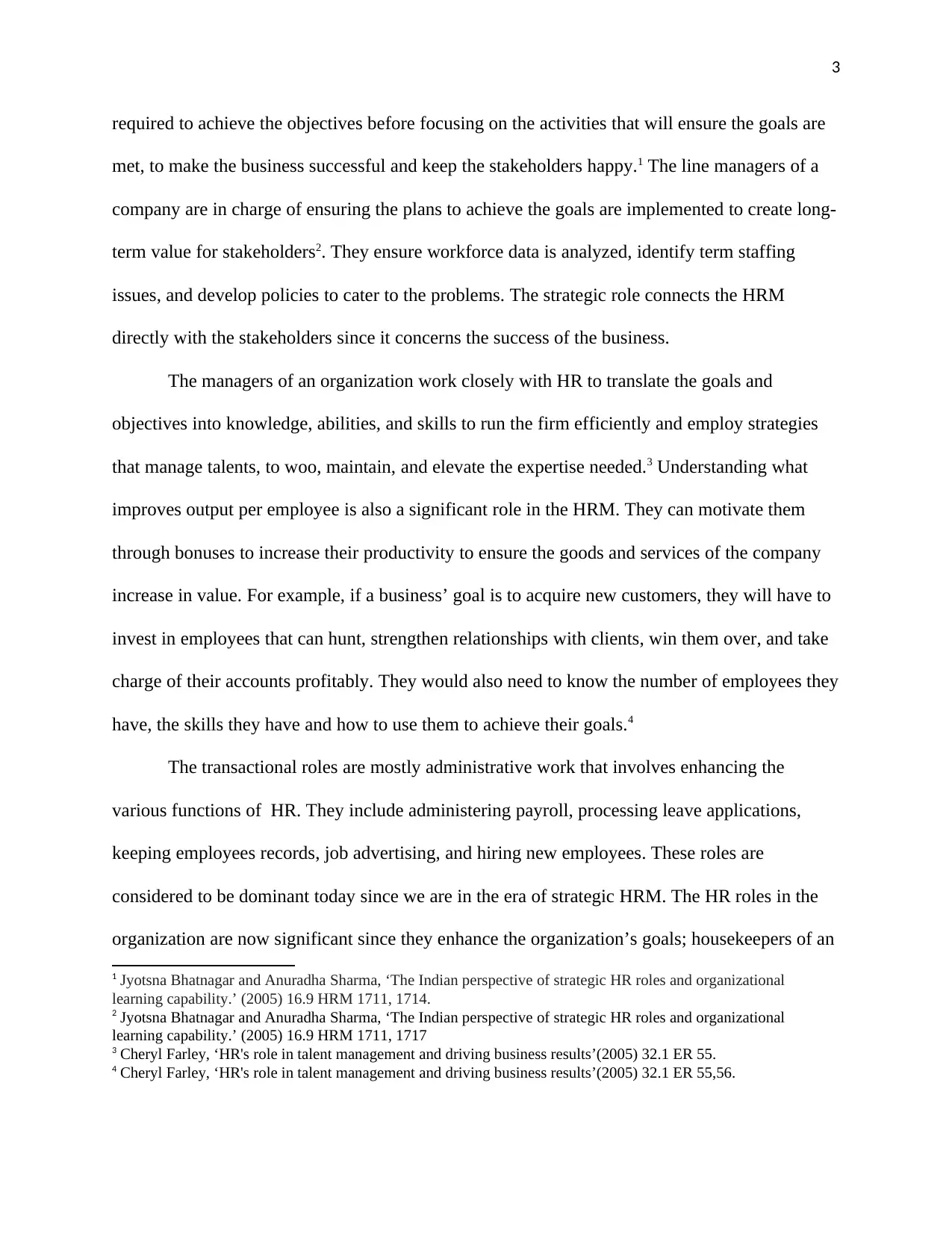
3
required to achieve the objectives before focusing on the activities that will ensure the goals are
met, to make the business successful and keep the stakeholders happy.1 The line managers of a
company are in charge of ensuring the plans to achieve the goals are implemented to create long-
term value for stakeholders2. They ensure workforce data is analyzed, identify term staffing
issues, and develop policies to cater to the problems. The strategic role connects the HRM
directly with the stakeholders since it concerns the success of the business.
The managers of an organization work closely with HR to translate the goals and
objectives into knowledge, abilities, and skills to run the firm efficiently and employ strategies
that manage talents, to woo, maintain, and elevate the expertise needed.3 Understanding what
improves output per employee is also a significant role in the HRM. They can motivate them
through bonuses to increase their productivity to ensure the goods and services of the company
increase in value. For example, if a business’ goal is to acquire new customers, they will have to
invest in employees that can hunt, strengthen relationships with clients, win them over, and take
charge of their accounts profitably. They would also need to know the number of employees they
have, the skills they have and how to use them to achieve their goals.4
The transactional roles are mostly administrative work that involves enhancing the
various functions of HR. They include administering payroll, processing leave applications,
keeping employees records, job advertising, and hiring new employees. These roles are
considered to be dominant today since we are in the era of strategic HRM. The HR roles in the
organization are now significant since they enhance the organization’s goals; housekeepers of an
1 Jyotsna Bhatnagar and Anuradha Sharma, ‘The Indian perspective of strategic HR roles and organizational
learning capability.’ (2005) 16.9 HRM 1711, 1714.
2 Jyotsna Bhatnagar and Anuradha Sharma, ‘The Indian perspective of strategic HR roles and organizational
learning capability.’ (2005) 16.9 HRM 1711, 1717
3 Cheryl Farley, ‘HR's role in talent management and driving business results’(2005) 32.1 ER 55.
4 Cheryl Farley, ‘HR's role in talent management and driving business results’(2005) 32.1 ER 55,56.
required to achieve the objectives before focusing on the activities that will ensure the goals are
met, to make the business successful and keep the stakeholders happy.1 The line managers of a
company are in charge of ensuring the plans to achieve the goals are implemented to create long-
term value for stakeholders2. They ensure workforce data is analyzed, identify term staffing
issues, and develop policies to cater to the problems. The strategic role connects the HRM
directly with the stakeholders since it concerns the success of the business.
The managers of an organization work closely with HR to translate the goals and
objectives into knowledge, abilities, and skills to run the firm efficiently and employ strategies
that manage talents, to woo, maintain, and elevate the expertise needed.3 Understanding what
improves output per employee is also a significant role in the HRM. They can motivate them
through bonuses to increase their productivity to ensure the goods and services of the company
increase in value. For example, if a business’ goal is to acquire new customers, they will have to
invest in employees that can hunt, strengthen relationships with clients, win them over, and take
charge of their accounts profitably. They would also need to know the number of employees they
have, the skills they have and how to use them to achieve their goals.4
The transactional roles are mostly administrative work that involves enhancing the
various functions of HR. They include administering payroll, processing leave applications,
keeping employees records, job advertising, and hiring new employees. These roles are
considered to be dominant today since we are in the era of strategic HRM. The HR roles in the
organization are now significant since they enhance the organization’s goals; housekeepers of an
1 Jyotsna Bhatnagar and Anuradha Sharma, ‘The Indian perspective of strategic HR roles and organizational
learning capability.’ (2005) 16.9 HRM 1711, 1714.
2 Jyotsna Bhatnagar and Anuradha Sharma, ‘The Indian perspective of strategic HR roles and organizational
learning capability.’ (2005) 16.9 HRM 1711, 1717
3 Cheryl Farley, ‘HR's role in talent management and driving business results’(2005) 32.1 ER 55.
4 Cheryl Farley, ‘HR's role in talent management and driving business results’(2005) 32.1 ER 55,56.
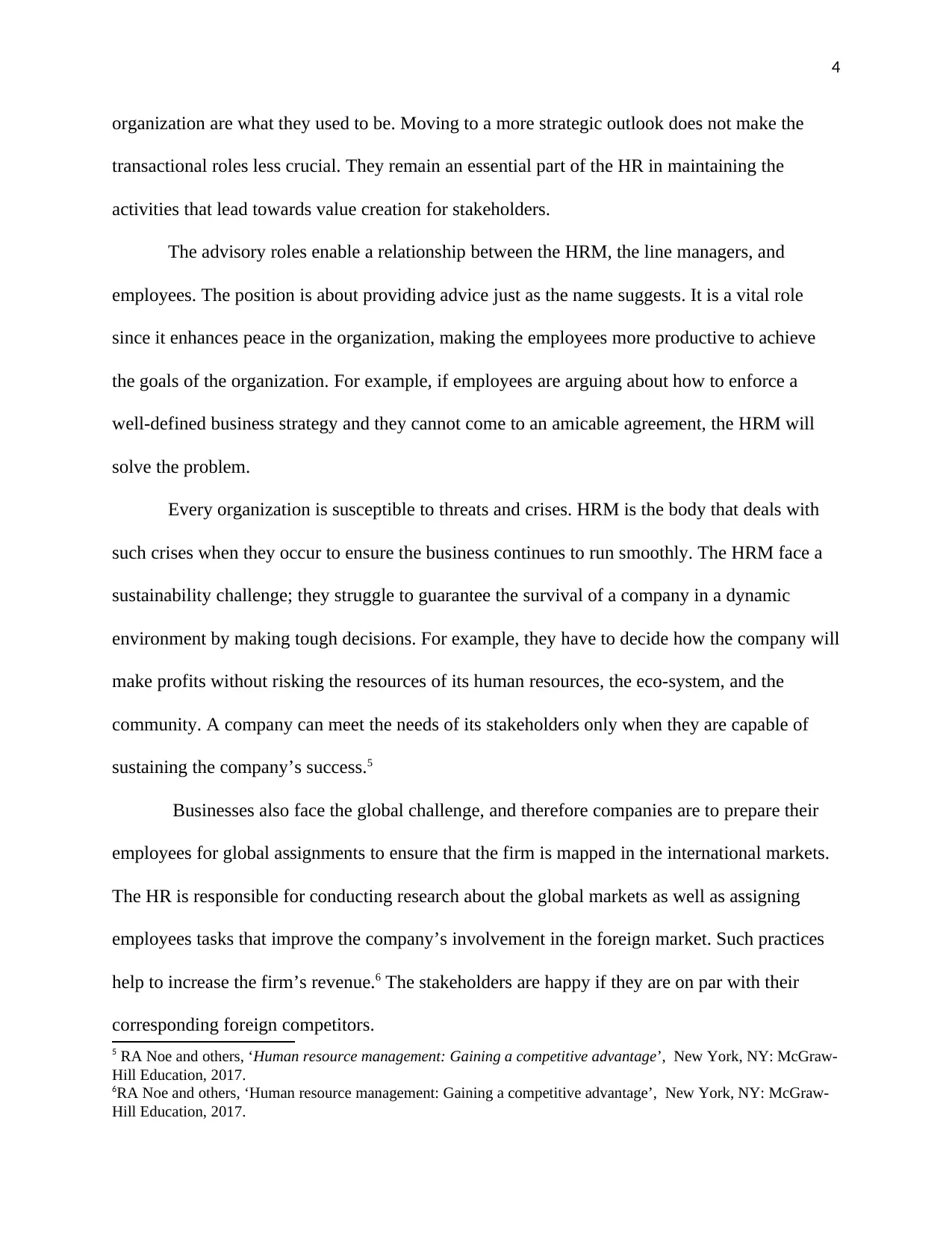
4
organization are what they used to be. Moving to a more strategic outlook does not make the
transactional roles less crucial. They remain an essential part of the HR in maintaining the
activities that lead towards value creation for stakeholders.
The advisory roles enable a relationship between the HRM, the line managers, and
employees. The position is about providing advice just as the name suggests. It is a vital role
since it enhances peace in the organization, making the employees more productive to achieve
the goals of the organization. For example, if employees are arguing about how to enforce a
well-defined business strategy and they cannot come to an amicable agreement, the HRM will
solve the problem.
Every organization is susceptible to threats and crises. HRM is the body that deals with
such crises when they occur to ensure the business continues to run smoothly. The HRM face a
sustainability challenge; they struggle to guarantee the survival of a company in a dynamic
environment by making tough decisions. For example, they have to decide how the company will
make profits without risking the resources of its human resources, the eco-system, and the
community. A company can meet the needs of its stakeholders only when they are capable of
sustaining the company’s success.5
Businesses also face the global challenge, and therefore companies are to prepare their
employees for global assignments to ensure that the firm is mapped in the international markets.
The HR is responsible for conducting research about the global markets as well as assigning
employees tasks that improve the company’s involvement in the foreign market. Such practices
help to increase the firm’s revenue.6 The stakeholders are happy if they are on par with their
corresponding foreign competitors.
5 RA Noe and others, ‘Human resource management: Gaining a competitive advantage’, New York, NY: McGraw-
Hill Education, 2017.
6RA Noe and others, ‘Human resource management: Gaining a competitive advantage’, New York, NY: McGraw-
Hill Education, 2017.
organization are what they used to be. Moving to a more strategic outlook does not make the
transactional roles less crucial. They remain an essential part of the HR in maintaining the
activities that lead towards value creation for stakeholders.
The advisory roles enable a relationship between the HRM, the line managers, and
employees. The position is about providing advice just as the name suggests. It is a vital role
since it enhances peace in the organization, making the employees more productive to achieve
the goals of the organization. For example, if employees are arguing about how to enforce a
well-defined business strategy and they cannot come to an amicable agreement, the HRM will
solve the problem.
Every organization is susceptible to threats and crises. HRM is the body that deals with
such crises when they occur to ensure the business continues to run smoothly. The HRM face a
sustainability challenge; they struggle to guarantee the survival of a company in a dynamic
environment by making tough decisions. For example, they have to decide how the company will
make profits without risking the resources of its human resources, the eco-system, and the
community. A company can meet the needs of its stakeholders only when they are capable of
sustaining the company’s success.5
Businesses also face the global challenge, and therefore companies are to prepare their
employees for global assignments to ensure that the firm is mapped in the international markets.
The HR is responsible for conducting research about the global markets as well as assigning
employees tasks that improve the company’s involvement in the foreign market. Such practices
help to increase the firm’s revenue.6 The stakeholders are happy if they are on par with their
corresponding foreign competitors.
5 RA Noe and others, ‘Human resource management: Gaining a competitive advantage’, New York, NY: McGraw-
Hill Education, 2017.
6RA Noe and others, ‘Human resource management: Gaining a competitive advantage’, New York, NY: McGraw-
Hill Education, 2017.
Secure Best Marks with AI Grader
Need help grading? Try our AI Grader for instant feedback on your assignments.
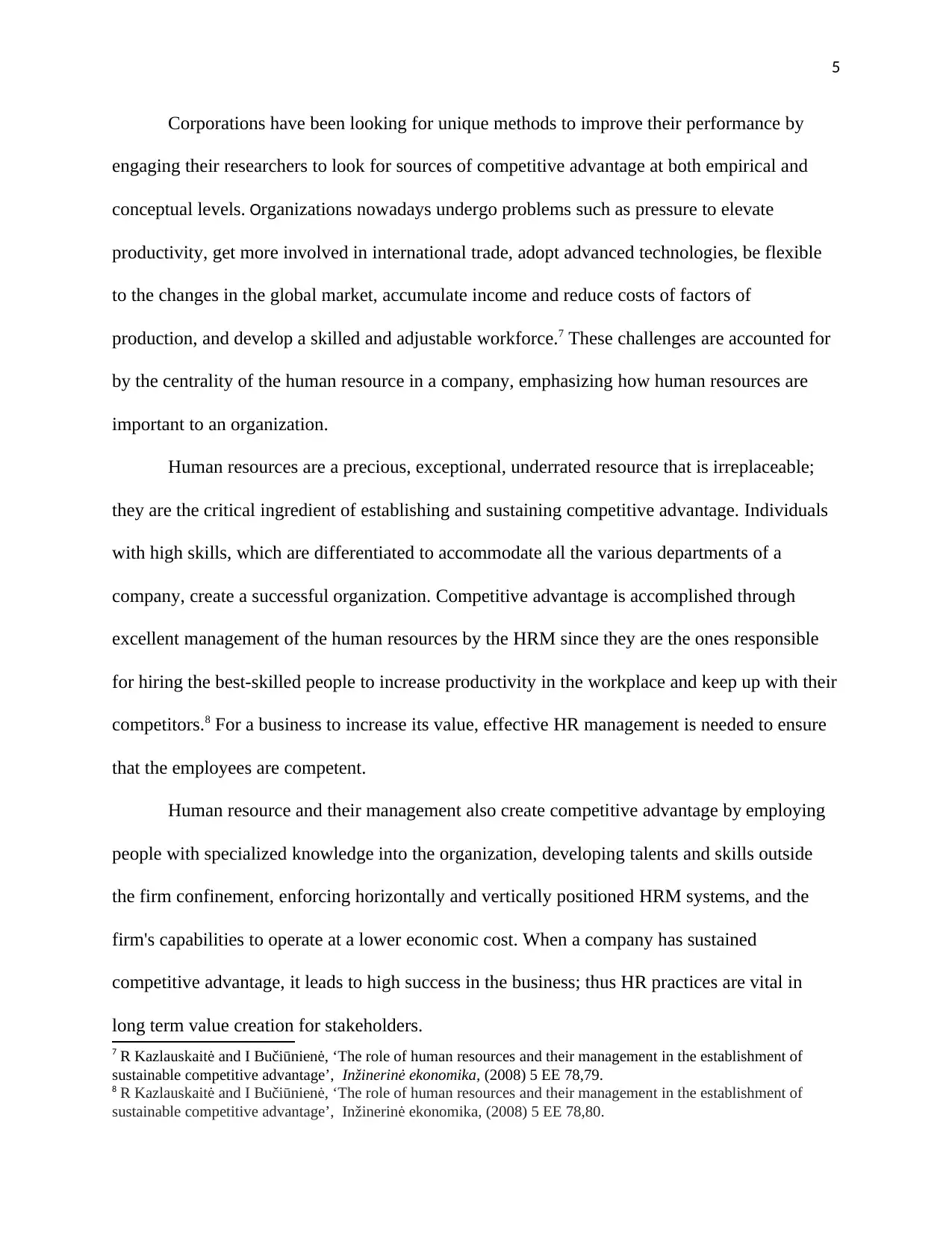
5
Corporations have been looking for unique methods to improve their performance by
engaging their researchers to look for sources of competitive advantage at both empirical and
conceptual levels. Organizations nowadays undergo problems such as pressure to elevate
productivity, get more involved in international trade, adopt advanced technologies, be flexible
to the changes in the global market, accumulate income and reduce costs of factors of
production, and develop a skilled and adjustable workforce.7 These challenges are accounted for
by the centrality of the human resource in a company, emphasizing how human resources are
important to an organization.
Human resources are a precious, exceptional, underrated resource that is irreplaceable;
they are the critical ingredient of establishing and sustaining competitive advantage. Individuals
with high skills, which are differentiated to accommodate all the various departments of a
company, create a successful organization. Competitive advantage is accomplished through
excellent management of the human resources by the HRM since they are the ones responsible
for hiring the best-skilled people to increase productivity in the workplace and keep up with their
competitors.8 For a business to increase its value, effective HR management is needed to ensure
that the employees are competent.
Human resource and their management also create competitive advantage by employing
people with specialized knowledge into the organization, developing talents and skills outside
the firm confinement, enforcing horizontally and vertically positioned HRM systems, and the
firm's capabilities to operate at a lower economic cost. When a company has sustained
competitive advantage, it leads to high success in the business; thus HR practices are vital in
long term value creation for stakeholders.
7 R Kazlauskaitė and I Bučiūnienė, ‘The role of human resources and their management in the establishment of
sustainable competitive advantage’, Inžinerinė ekonomika, (2008) 5 EE 78,79.
8 R Kazlauskaitė and I Bučiūnienė, ‘The role of human resources and their management in the establishment of
sustainable competitive advantage’, Inžinerinė ekonomika, (2008) 5 EE 78,80.
Corporations have been looking for unique methods to improve their performance by
engaging their researchers to look for sources of competitive advantage at both empirical and
conceptual levels. Organizations nowadays undergo problems such as pressure to elevate
productivity, get more involved in international trade, adopt advanced technologies, be flexible
to the changes in the global market, accumulate income and reduce costs of factors of
production, and develop a skilled and adjustable workforce.7 These challenges are accounted for
by the centrality of the human resource in a company, emphasizing how human resources are
important to an organization.
Human resources are a precious, exceptional, underrated resource that is irreplaceable;
they are the critical ingredient of establishing and sustaining competitive advantage. Individuals
with high skills, which are differentiated to accommodate all the various departments of a
company, create a successful organization. Competitive advantage is accomplished through
excellent management of the human resources by the HRM since they are the ones responsible
for hiring the best-skilled people to increase productivity in the workplace and keep up with their
competitors.8 For a business to increase its value, effective HR management is needed to ensure
that the employees are competent.
Human resource and their management also create competitive advantage by employing
people with specialized knowledge into the organization, developing talents and skills outside
the firm confinement, enforcing horizontally and vertically positioned HRM systems, and the
firm's capabilities to operate at a lower economic cost. When a company has sustained
competitive advantage, it leads to high success in the business; thus HR practices are vital in
long term value creation for stakeholders.
7 R Kazlauskaitė and I Bučiūnienė, ‘The role of human resources and their management in the establishment of
sustainable competitive advantage’, Inžinerinė ekonomika, (2008) 5 EE 78,79.
8 R Kazlauskaitė and I Bučiūnienė, ‘The role of human resources and their management in the establishment of
sustainable competitive advantage’, Inžinerinė ekonomika, (2008) 5 EE 78,80.
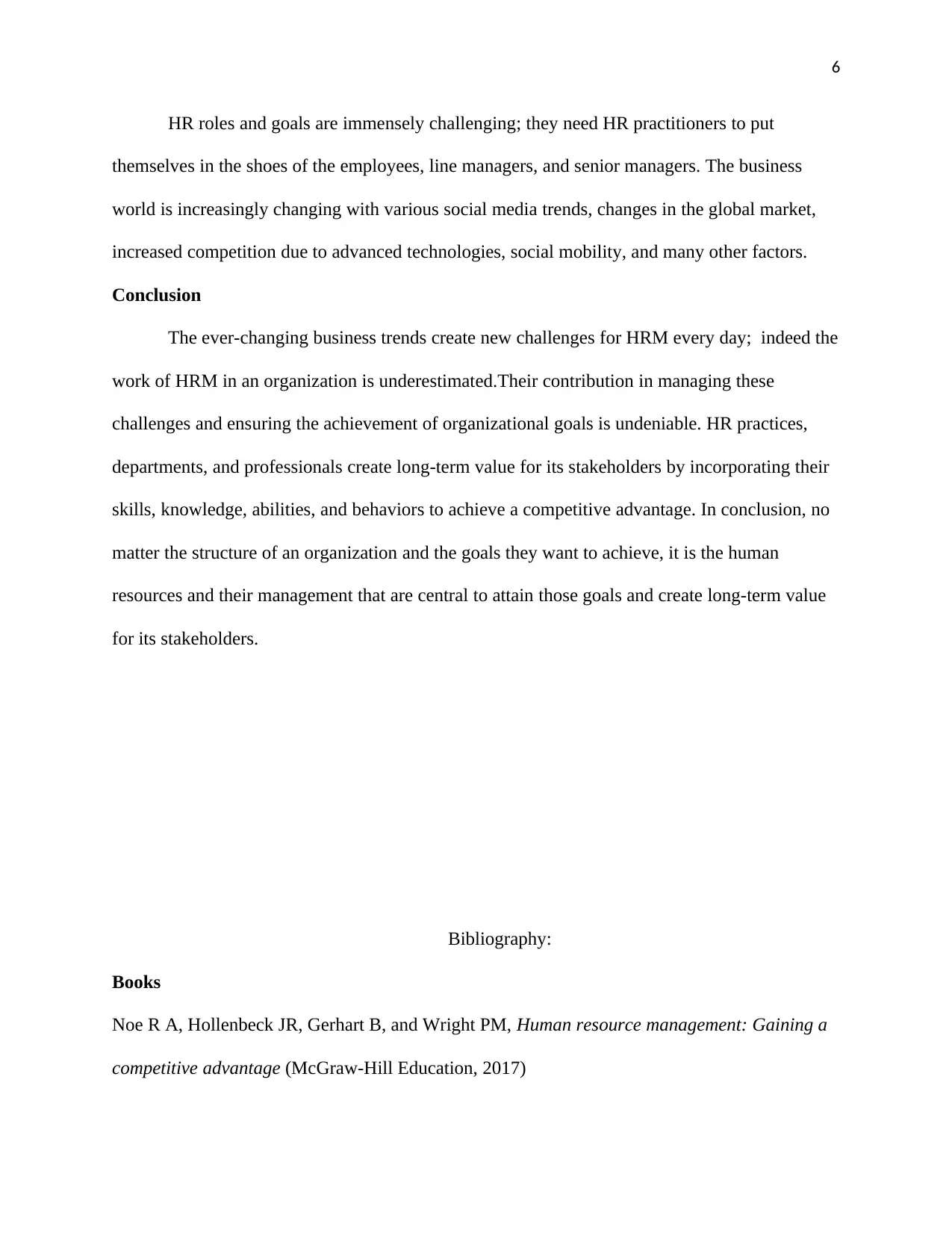
6
HR roles and goals are immensely challenging; they need HR practitioners to put
themselves in the shoes of the employees, line managers, and senior managers. The business
world is increasingly changing with various social media trends, changes in the global market,
increased competition due to advanced technologies, social mobility, and many other factors.
Conclusion
The ever-changing business trends create new challenges for HRM every day; indeed the
work of HRM in an organization is underestimated.Their contribution in managing these
challenges and ensuring the achievement of organizational goals is undeniable. HR practices,
departments, and professionals create long-term value for its stakeholders by incorporating their
skills, knowledge, abilities, and behaviors to achieve a competitive advantage. In conclusion, no
matter the structure of an organization and the goals they want to achieve, it is the human
resources and their management that are central to attain those goals and create long-term value
for its stakeholders.
Bibliography:
Books
Noe R A, Hollenbeck JR, Gerhart B, and Wright PM, Human resource management: Gaining a
competitive advantage (McGraw-Hill Education, 2017)
HR roles and goals are immensely challenging; they need HR practitioners to put
themselves in the shoes of the employees, line managers, and senior managers. The business
world is increasingly changing with various social media trends, changes in the global market,
increased competition due to advanced technologies, social mobility, and many other factors.
Conclusion
The ever-changing business trends create new challenges for HRM every day; indeed the
work of HRM in an organization is underestimated.Their contribution in managing these
challenges and ensuring the achievement of organizational goals is undeniable. HR practices,
departments, and professionals create long-term value for its stakeholders by incorporating their
skills, knowledge, abilities, and behaviors to achieve a competitive advantage. In conclusion, no
matter the structure of an organization and the goals they want to achieve, it is the human
resources and their management that are central to attain those goals and create long-term value
for its stakeholders.
Bibliography:
Books
Noe R A, Hollenbeck JR, Gerhart B, and Wright PM, Human resource management: Gaining a
competitive advantage (McGraw-Hill Education, 2017)
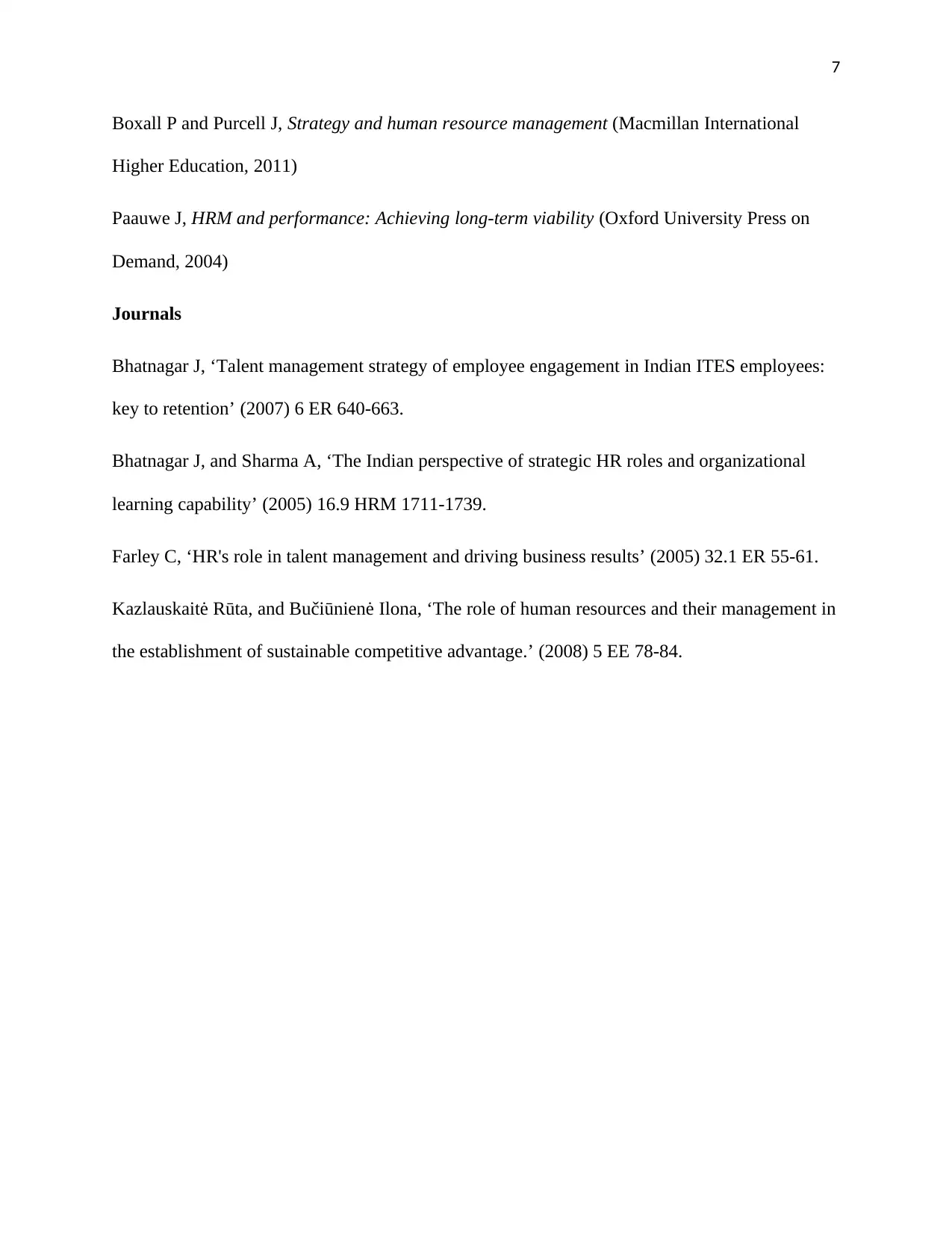
7
Boxall P and Purcell J, Strategy and human resource management (Macmillan International
Higher Education, 2011)
Paauwe J, HRM and performance: Achieving long-term viability (Oxford University Press on
Demand, 2004)
Journals
Bhatnagar J, ‘Talent management strategy of employee engagement in Indian ITES employees:
key to retention’ (2007) 6 ER 640-663.
Bhatnagar J, and Sharma A, ‘The Indian perspective of strategic HR roles and organizational
learning capability’ (2005) 16.9 HRM 1711-1739.
Farley C, ‘HR's role in talent management and driving business results’ (2005) 32.1 ER 55-61.
Kazlauskaitė Rūta, and Bučiūnienė Ilona, ‘The role of human resources and their management in
the establishment of sustainable competitive advantage.’ (2008) 5 EE 78-84.
Boxall P and Purcell J, Strategy and human resource management (Macmillan International
Higher Education, 2011)
Paauwe J, HRM and performance: Achieving long-term viability (Oxford University Press on
Demand, 2004)
Journals
Bhatnagar J, ‘Talent management strategy of employee engagement in Indian ITES employees:
key to retention’ (2007) 6 ER 640-663.
Bhatnagar J, and Sharma A, ‘The Indian perspective of strategic HR roles and organizational
learning capability’ (2005) 16.9 HRM 1711-1739.
Farley C, ‘HR's role in talent management and driving business results’ (2005) 32.1 ER 55-61.
Kazlauskaitė Rūta, and Bučiūnienė Ilona, ‘The role of human resources and their management in
the establishment of sustainable competitive advantage.’ (2008) 5 EE 78-84.
1 out of 7
Related Documents
Your All-in-One AI-Powered Toolkit for Academic Success.
+13062052269
info@desklib.com
Available 24*7 on WhatsApp / Email
![[object Object]](/_next/static/media/star-bottom.7253800d.svg)
Unlock your academic potential
© 2024 | Zucol Services PVT LTD | All rights reserved.





